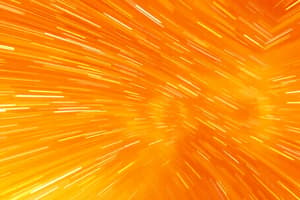Podcast
Questions and Answers
The physical quantities
which can be treated as
independent of other physical
quantities are called
The physical quantities which can be treated as independent of other physical quantities are called
FUNDAMENTAL QUANTITIES
The physical quantities
whose defining operations
are based on other physical
quantities, are called
The physical quantities whose defining operations are based on other physical quantities, are called
DERIVED QUANTITY
Quantities that are described
by their magnitude ONLY
Quantities that are described by their magnitude ONLY
SCALAR
Quantities that are described
by their magnitude AND
direction.
Quantities that are described by their magnitude AND direction.
It is a scalar quantity that refers
to "how much ground an object
has covered" during its motion.
It is a scalar quantity that refers to "how much ground an object has covered" during its motion.
It is a vector quantity that refers t
o "how far out of place an object is“
It is the object's overall change in
position.
It is a vector quantity that refers t o "how far out of place an object is“ It is the object's overall change in position.
Resultant is a vector sum of more than one vector.
It is combining vectors having different magnitude and direction.
It is represented by one single vector called resultant vector.
Resultant is a vector sum of more than one vector. It is combining vectors having different magnitude and direction. It is represented by one single vector called resultant vector.
is any substance
that has mass and takes
up space by having
volume.
is any substance that has mass and takes up space by having volume.
is the quantitative
property that must be
transferred to an object
to perform work.
is the quantitative property that must be transferred to an object to perform work.
The study of forces acting on
bodies whether at rest or at
motion.
The study of forces acting on bodies whether at rest or at motion.
It studies the production
and properties of sounds
It studies the production and properties of sounds
The study of the relationship
between heat and other forms
of energy.
The study of the relationship between heat and other forms of energy.
The study of the nature
and behavior of light.
The study of the nature and behavior of light.
The study of the properties of electric
current and magnetism and their
relationship.
The study of the properties of electric current and magnetism and their relationship.
The study of the discrete nature of
phenomena at the atomic and subatomic
levels its focus is on the invisible units of
energy called quanta.
The study of the discrete nature of phenomena at the atomic and subatomic levels its focus is on the invisible units of energy called quanta.
The study of the components,
structure and behavior of the
nucleus of the atom.
The study of the components, structure and behavior of the nucleus of the atom.
The study of the phenomena that takes
place in a forms of reference that is in
motion with respect to an observer.
The study of the phenomena that takes place in a forms of reference that is in motion with respect to an observer.
The study of all properties of solid
materials including electrical conduction in
crystals of semi-conduction and metals.
The study of all properties of solid materials including electrical conduction in crystals of semi-conduction and metals.
The study of highly ionized gases that
is, gases that have been separated into
positively and negatively charged
particles.
The study of highly ionized gases that is, gases that have been separated into positively and negatively charged particles.
BRANCHES OF PHYSICS Classical (pre-1900)
BRANCHES OF PHYSICS Classical (pre-1900)
BRANCHES OF PHYSICS Modern (post-1900)
BRANCHES OF PHYSICS Modern (post-1900)
an object is in motion if it change position relative to
a reference point.
an object is in motion if it change position relative to a reference point.
is the science of describing the motion of an
object quantitatively.
is the science of describing the motion of an object quantitatively.
“How fast something is moving.”
“How fast something is moving.”
“It is the speed with direction.”
“It is the speed with direction.”
ACCELERATES IN THE DIRECTION IT IS MOVING
ACCELERATES IN THE DIRECTION IT IS MOVING
ACCELERATES IN THE OPPOSITE DIRECTION TO ITS MOVEMENT (SLOWS DOWN)
ACCELERATES IN THE OPPOSITE DIRECTION TO ITS MOVEMENT (SLOWS DOWN)
An object falling without air resistance or friction is defined to be
in
An object falling without air resistance or friction is defined to be in
opposes the motion of an object through the air
opposes the motion of an object through the air
opposes motion between two objects.
opposes motion between two objects.
SCIENCE OF MATTER AND ENERGY
SCIENCE OF MATTER AND ENERGY
Flashcards are hidden until you start studying




